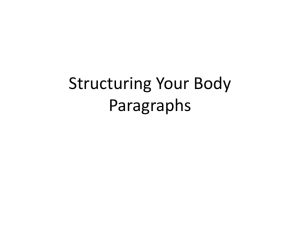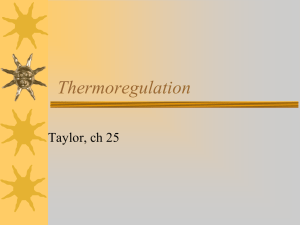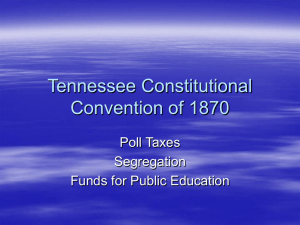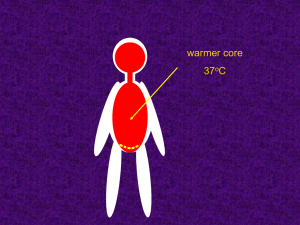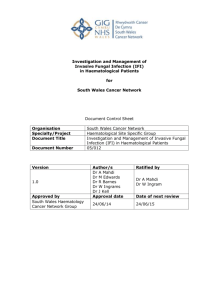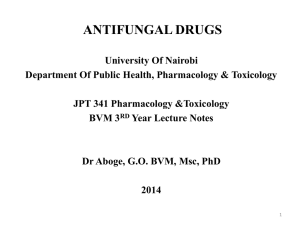Empirical or preemptive - Infectio
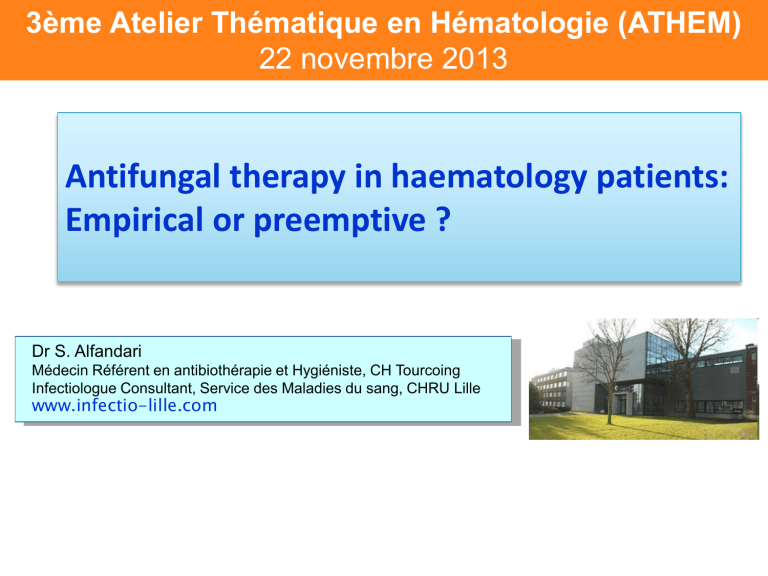
3ème Atelier Thématique en Hématologie (ATHEM)
22 novembre 2013
Antifungal therapy in haematology patients:
Empirical or preemptive ?
Dr S. Alfandari
Médecin Référent en antibiothérapie et Hygiéniste, CH Tourcoing
Infectiologue Consultant, Service des Maladies du sang, CHRU Lille www.infectio-lille.com
Potential conflicts of interest
Lectures: Gilead, MSD, Novartis, Pfizer
Meetings: Gilead, MSD, Pfizer, Sanofi
French ID society administrator:
Astellas - Astra Zeneca - Gilead - Viiv Healthcare - Janssen Cilag -
MSD - Sanofi Pasteur MSD - Pfizer - Bayer Pharma - BMS - Abbott -
Roche - Novartis – Vitalaire - Biofilm control - GSK - Celestis
What treatment are we talking about ?
All haematology patients
◦
No, that’s prophylaxis
Haematology patients with mycological evidence of IFI
◦
No, that’s targeted treatment
Febrile neutropenia patients
◦
Yes, but which patients ?
Empirical antifungal therapy in febrile neutropenia patients
Standard of care since the 2002 IDSA guidelines
Supporting studies
◦
Pizzo et al. AMJ 1982
50 patients with fever & 7 days broad spectrum AB randomized to
AB stop/continuing AB/ AB + amphotericin B
Infections: 9/6/2
◦
EORTC. AMJ 1989
132 patients with fever & 4 days AB randomized w - w/o AmB
1,5% (n=1) vs 9% IFI (n=6)
No significant difference in overall mortality
Three large trials: similar results - few events
Pro/con empirical AF therapy
Pro
◦
Early IFI Rx
◦
Another step in antimicrobial therapy
Might delay escalation therapy to carbapenems
Psychological support: « we DO something » to treat the fever
Con
◦
Most patients receive unnecessary Rx: no infection/no IFI
◦
Adverse events
◦
Costs
◦
New diagnostic tools allow for early diagnosis
Why is this a hot issue ?
Decreasing IFI risk in haematology patients
◦
90’s
17-25% in AML/allograft (Bodey, EJCMID 1992, Guiot CID 1994)
◦
00’s
~10% in AML (Nosary, AJH 2001, Cornely, NEJM 2007) and allograft
(Ullmann, NEJM 2007)
Including arms without mould-active prophylaxis from randomized trials
◦
10’s
Unfrequent event with generalized mould-active prophylaxis
<5%
High antifungal costs
◦
~830000€/year (1M $) in Lille Haematology department
◦
~90% of antiinfectives costs
A new strategy: preemptive therapy
Empirical
◦
Fever driven
Pre-emptive
◦
Diagnostic driven
Biomarkers
Imaging
◦
Non standardized definition: confusion risk in literature
No consensus on the criteria for a pre-emptive strategy
Clinical:
◦
Pneumonia
Imaging:
◦
Typical or not?
Biomarkers:
◦
Galactomannan antigenemia
◦
-D glucan
◦
PCR
◦
Mannan, antimannan
Combinations of several criteria ?
Slide courtesy C Cordonnier
Galactomannan and CT-Based
Preemptive Antifungal Therapy
Maertens et al CID 2005; 41:1242–50
Galactomannan and CT-Based
Preemptive Antifungal Therapy
117 febrile episodes
30 persistent fever / 28 relapsing fever while ATB
◦
41 (30%) with empirical criteria
◦
9 have GM Ag + and receive AF
32 Rx NOT given
10 non febrile episodes with GM Ag + treated
Outcome:
◦
Overall survival: 81,9%
◦
22 IFD with 3 breakthrough infections
2 non fatal candidemias
One autopsy diagnosed zygomycosis (non febrile)
Maertens et al CID 2005; 41:1242–50
PCR-Based Preemptive Antifungal
Therapy
403 allo-HSCT, Day-100 fu, randomized to
AmB-L 3 mg/kg/d
A- PCR monitoring (n=196)
◦
1x PCR+ or persistent fever >5 d or pulm infiltrate:
B- Empirical antifungal therapy (n=207)
◦
Persistent fever >5 d (w ou w/o PCR+) or pulm infiltrate
PCR Empirical p
N treated 112 (57.1%) 76 (36.7%)
N proven/probable IFI 16 17
N death D30
N total death D100
4 (1.5%)
32
13 (6.3%)
34
0.003
NS
0.015
NS
Hebart et al BMT 2009;43: 553-61
Multiple criteria based Preemptive
Antifungal Therapy
Drug: AmB or AmB-L daily / CrCl
Empirical arm
◦
Fever driven
Pre-emptive arm
◦
Pneumonia, shock, skin lesions evocative of IFI, sinusitis, orbititis, hepatosplenic abscesses, grade 4 mucositis,
◦
Aspergillus colonization, or one GM Ag +
Cordonnier et al CID 2009 48:1042–51
Multiple criteria based Preemptive
Antifungal Therapy
Fever before ATF (d)
Duration of fever (d)
Patients with ATF %
Days of ATF
Survival
Proven/probable IFI
Empirical (N=150) Preemptive (N=143) P
7
18.3
62.7
7.4
97%
2,7%
13
18.3
39.2
4.5
95%
9%
<.01
NS
<10 -4
<.01
NS
<0.02
Cordonnier et al CID 2009 48:1042–51
Multiple criteria based Preemptive
Antifungal Therapy
Empirical
15 Days Neutropenia
Consolidation AML or
Auto-HSCT
Induction
AML
Pre-emptive
IFI in Pre-emptive
IFI in Empirical
Cordonnier et al CID 2009 48:1042–51
Cordonnier et al, Clin Infect Dis, 2009; 48: 1042-1051
Clinically driven Preemptive Antifungal
Therapy
Observational study, 146 AL/auto-HSCT pts
◦
220 neutropenic episodes (NE)
◦
Intensive diagnosis work-up if fever > 4d or recurrent fever
3 consecutive daily GM, chest CT, etc…
◦
AF if: proven-probable-possible IFI or persistent fever + « clinical deterioration »
AF given: 48 / 159 (30.2%)
◦
84 / 159 (52.8%) if following usual guidelines
IFI Proven/probable: 14% (25% high risk patients)
Girmenia et al., J Clin Oncol, 2010;28:667-74
Observational: Empiric versus “preemptive”
Data collection 397 HM patients
◦
190 empirical (fever driven)
◦
207”pre-emptive” (imaging or mycology or non specific lab tests)
More probable/proven IFI in pre-emptive arm
◦
23.7 vs 7.4% - p<0.001
Increased IFI mortality in pre-emptive arm
◦
22.5% vs 7.1%
Limits
◦
Non interventional, diagnostic work up not standardized, candida colonization included in preemptive
Pagano et al Haematologica 2011; 96:1363-70
PCR/CTscan-Based Preemptive
Antifungal Therapy
240 AML/allo-HSCT, open label, randomized study
Standard strategy:
Fever => CT scan+/-BAL
Empirical AF till results then back to prophylaxis or up to targeted
Biomarker strategy:
PCR/GM Ag + (or persistent fever if negative) => CT scan+/-BA
Preemptive AF if typical images
No AF if atypical or no CT abnormalities
Morrissey , et al. Lancet ID 2013;13:519
PCR/CTscan-Based Preemptive Antifungal
Therapy
AF use
Mortality
All-cause
IA-related
Other IFI-related
IA incidence
Proven
Probable
Possible
Other IFI incidence
Proven
Probable
Standard group
(n=122)
39 (32%)
Biomarker group
(n=118)
18 (15%) p
0·002
18 (15%)
6 (5%)
0
1 (1%)
0
0
4 (3%)
0
12 (10%)
3 (3%)
2 (2%)
1 (1%)
16 (14%)
6 (5%)
5 (4%)
1 (1%)
0·31
0·5
0·24
1·0
<0·0001
0·013
0·75
0·49
Morrissey , et al. Lancet ID 2013;13:519
Enrolling: EORTC 65091 trial
Allo HCST/ AML/ALL induction chemo
◦
Fluconazole prophylaxis for all patients
◦
One (sponsored) drug: caspofungin
◦
Assesment of PCR/GM/BDG
Empirical arm
◦
4-d fever (or recurring fever after 2-d apyrexia)
Pre-emptive arm
◦
GM Ag >0.5 or
◦
Aspergillus sputum culture or
◦
New infiltrate on chest X-ray or
◦
Dense limited lesion on CT scan
What we use in Lille: best of both worlds !
Widespread posaconazole prophylaxis
Switched to:
◦
Empirical therapy: Fever based &/or
◦
Preemptive therapy: Biomarkers/imaging based
Switched back to posaconazole prophylaxis
◦
For fever/biomarkers based Rx and no nodules on CT scan
Patterns of IFI in practice
Maertens et al. Haematologica 2012;97:325-327.
Conclusion:
Preemptive therapy promising
◦
AF sparing
◦
IFI mortality seems lower then in empirical Rx
◦
More proven/probable IFI diagnosed
We need
◦
A standardized definition of preemptive therapy
◦
Better diagnostic tools
Standardized PCR
GM assays with = sensitivity in patients w or w/o posa proph
◦
Shorter delays for CT scan access (< 48h ?)



